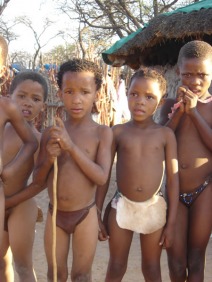EDUCATION: how do parents teach & train their children?
The methods employed for teaching children the skills of an adult and the ways of the culture in a foraging society are an outgrowth of the close familial proximity. In YANOMAMI society, learning comes about predominantly through sex-specific imitation(10). Young girls observe their mothers and other women going about their domestic, gardening, and gathering duties. At an early age they are encouraged to play at being adult women, and by at the age of about ten they become part-time working adults. Soon after this they relinquish their child status altogether and are fully incorporated into the village's body of working women. They also become eligible for marriage and childbearing at this time. Conversely, childhood extends much further for boys, often into the late teenage years. As with girls and their mothers, boys learn by imitation of their fathers. For example, a boy might construct a miniature shelter out of small sticks while watching his father build a real dwelling. Unlike with girls, however, a boy's period of "playing adult" lasts much longer and often comes to an end, at which point he joins up with peers for a delinquent, gang-like youth stage before it becomes time to take on the identity and responsibilities of a man.
In JU'/HOANSI society, mothers play a similar role in training their daughters through demonstration(11). This begins at an earlier age than for Yanomami girls; a Ju'/hoansi girl takes part in food gathering duties basically from the time she first learns to walk. For boys, learning for the most part does not come by way of the parents. As fathers are largely removed from the domestic sphere in their food-getting practices, they are not present to boys to serve as an instructive model. Boys learn adult skills instead by teaming up with peers and teaching themselves by trial and error, or by following the example of older boys in the community who have already progressed in their own learning.
The difference between the family education dynamic in the post-industrial society from that in the foraging society is an intriguing one. While the volume of learning a child experiences in suburban America is far greater than for a Yanomami or Ju'/hoansi child, the proportion of learning that comes by way of the parents is less for the American child. In the foraging society, nearly all basic faculties, sex-specific skills, and cultural knowledge and values are taught by parents or passed on through the combined efforts of parents and other adults in the social unit. In SUBURBAN AMERICA, while parents do play a similar instructive role in the aforementioned areas, a large body of culturally important knowledge called academia is typically conveyed by professional teachers outside the home in a school setting. Parents, nevertheless, are still the primary stimulators of capital development, which is defined as "all the processes that augment a child's cognitive, physical, and behavioral skills"(12). Furthermore, sex-specific education occurs within the post-industrial family just as it does in the foraging family. Statistics indicate that American fathers spend more time with their sons than they spend with their daughters, and that mothers spend more time with their daughters than they spend with their sons(13). A fair amount of this time is spent demonstrating and teaching traditionally masculine and feminine skills, such as cooking for girls and handiwork for boys.
References:
10. Chagnon 1992
11. Barnard 1992
12. Bryant and Zick 1996
13. Bryant and Zick 1996
In JU'/HOANSI society, mothers play a similar role in training their daughters through demonstration(11). This begins at an earlier age than for Yanomami girls; a Ju'/hoansi girl takes part in food gathering duties basically from the time she first learns to walk. For boys, learning for the most part does not come by way of the parents. As fathers are largely removed from the domestic sphere in their food-getting practices, they are not present to boys to serve as an instructive model. Boys learn adult skills instead by teaming up with peers and teaching themselves by trial and error, or by following the example of older boys in the community who have already progressed in their own learning.
The difference between the family education dynamic in the post-industrial society from that in the foraging society is an intriguing one. While the volume of learning a child experiences in suburban America is far greater than for a Yanomami or Ju'/hoansi child, the proportion of learning that comes by way of the parents is less for the American child. In the foraging society, nearly all basic faculties, sex-specific skills, and cultural knowledge and values are taught by parents or passed on through the combined efforts of parents and other adults in the social unit. In SUBURBAN AMERICA, while parents do play a similar instructive role in the aforementioned areas, a large body of culturally important knowledge called academia is typically conveyed by professional teachers outside the home in a school setting. Parents, nevertheless, are still the primary stimulators of capital development, which is defined as "all the processes that augment a child's cognitive, physical, and behavioral skills"(12). Furthermore, sex-specific education occurs within the post-industrial family just as it does in the foraging family. Statistics indicate that American fathers spend more time with their sons than they spend with their daughters, and that mothers spend more time with their daughters than they spend with their sons(13). A fair amount of this time is spent demonstrating and teaching traditionally masculine and feminine skills, such as cooking for girls and handiwork for boys.
References:
10. Chagnon 1992
11. Barnard 1992
12. Bryant and Zick 1996
13. Bryant and Zick 1996


